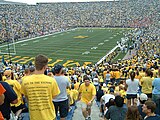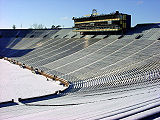Michigan Stadium
"The Big House" | |
 | |
 | |
| Location | South Main Street & E Stadium Blvd Ann Arbor, Michigan 48109 |
|---|---|
| Owner | University of Michigan |
| Operator | University of Michigan |
| Capacity | 107,501 |
| Surface | Field Turf |
| Construction | |
| Broke ground | 1926 |
| Opened | 1927 |
| Construction cost | $950,000 USD |
| Architect | Bernard Green |
| Tenants | |
| Michigan Wolverines (NCAA) (1927-Present) | |
Michigan Stadium, nicknamed The Big House, is the football stadium for the University of Michigan in Ann Arbor, Michigan. It was built in 1927, at a cost of $950,000 and had an original capacity of 72,000.[1] Prior to playing football at the stadium, the Wolverines played on Ferry Field. Today, Michigan Stadium has an official capacity of 107,501, though football game attendance often exceeds 111,000 when bands, stadium staff, and others are added. The largest crowd in NCAA college football history was 112,118 on November 22, 2003 for a game against Ohio State.[2]
It is the largest American football stadium, the fifth largest stadium in the world, and the 30th largest sports venue in general (which includes NASCAR and horse racing tracks, among others).[1] The one "extra seat" in its capacity was "reserved" by former head coach Fielding Yost for the then athletic director Fritz Crisler, although its location is not specified.[2] Home games are invariably sellouts, and residents of Ann Arbor are aware of "football Saturdays" because of the influx of traffic and business at local establishments. The size of the crowd in the stadium nearly matches the city's population of 114,000.
Michigan Stadium was designed with footings to allow the stadium's capacity to be expanded beyond 100,000. According to the University of Michigan Library's and Athletics Department's history of the stadium, then-athletic director Fielding Yost envisioned a day where 150,000 seats would be needed. To keep construction costs low at the time, the decision was made to build a smaller stadium than Yost envisioned but include the footings for future expansion.[3]
Michigan Stadium is also the site of University of Michigan main graduation ceremonies.
History
Michigan Stadium's size is not entirely apparent to outside observers, as it is constructed partially below grade, leaving only the upper 20 rows (in most sections) visible from the outside. The stadium's original capacity was 72,000, but Yost made certain to install steel footings that could allow for expansion. Initially, all seating consisted of wood bleachers. These were replaced with permanent metal seating in 1949 by Crisler, who had become athletic director. Longtime radio announcer Bob Ufer dubbed Michigan Stadium "The hole that Yost dug, Crisler paid for, Canham carpeted, and Schembechler fills every cotton-pickin' Saturday afternoon." Since 1975 — Bo Schembechler's seventh season as coach — the stadium has held over 100,000 fans for every home game. (The game against Indiana University on October 25, 1975 was the last sub-100,000 attendance home game for Michigan.) Michigan's game versus Ball State University on November 4, 2006 was the 200th consecutive crowd of over 100,000 fans. Traditionally, when the game's attendance is announced, the public address announcer thanks the fans for "being part of the largest crowd watching a football game anywhere in America." The tradition was temporarily stopped in 1996, when Michigan Stadium's capacity was overtaken by that of Neyland Stadium, but resumed when it was expanded two years later. Despite its size, Michigan Stadium has a reputation for being relatively quiet[citation needed]; Some claim this is due to the lack of decks that would otherwise trap the sound on the field.[citation needed]

On October 1, 1927, Michigan played Ohio Wesleyan in the first game at Michigan Stadium. It was an instant success, and Michigan prevailed easily, 33-0. The new stadium was then formally dedicated three weeks later in a contest against Ohio State on October 22, 1927. Michigan had spoiled the formal dedication of Ohio Stadium in Columbus just five years earlier, and was victorious again in the contest played for the new dedication, besting the Buckeyes 21-0 before a capacity crowd of 84,401.
From 1927 to 1968, the stadium's field was covered in natural grass. This was replaced with TartanTurf in 1969 to give players better traction. However, this surface was thought to be unforgiving on players' joints, and the stadium returned to natural turf in 1991. This too became problematic, as the field's below-surface location near the water table made it difficult for grass to permanently take root. The field was converted to FieldTurf, an artificial surface designed to give grass-like playing characteristics, in 2003.
On September 9, 2006, attendees of the Michigan Wolverines vs. Central Michigan Chippewas football game had to endure the first weather delay in the Stadium's history, after a lightning strike occurred shortly after 12:30 EDT in the afternoon. The game was delayed for approximately one hour.
Renovation plan
On June 21, 2007, the University's Board of Regents approved a $226 million renovation and expansion project for Michigan Stadium which is expected to be completed by 2010. The project includes replacement of some bleachers, widening of individual seats, widening of the aisles and installing hand rails, and the addition of a new press box, 83 luxury boxes, 3,200 club seats, raising its total seating capacity from 107,501 to over 108,000.[3] This renovation plan has garnered much opposition from students, alumni, and fans around the country.[4] A disabled-veterans group filed a federal lawsuit against the university on April 17, because in their view the design of the project does not meet federal standards for wheelchair-accessible seating.[5]
In March 2008, the University reached a settlement to drop the lawsuit in exchange for adding more accessible seating in place of current seating during the course of the renovation. As a result of this change, the capacity of the stadium will decrease to an estimated 106,201 seats for the 2008 and 2009 seasons, placing it second behind Penn State's Beaver Stadium. Since the current plans are still not finalized, it is currently uncertain when, if ever, Michigan Stadium will return to its status of the largest football stadium.[6]
Students, faculty, and alumni have all come out in opposition to the University's controversial plan to renovate the stadium. President Coleman and the Michigan Board of Regents, however, do not appear to be willing to negotiate with any of them on the future of the stadium.
- Images
-
View from the student section during a game between Michigan and Miami University (OH), 2004.
-
Michigan Stadium, winter 2002.
-
Exterior of Michigan Stadium, winter 2002.
-
Graduation ceremony at Michigan Stadium, 2003.
-
The stadium filled for a football game
-
Exterior view
-
South end of the stadium.
-
Press Box, viewed from the west.
Notes
- ^ www.worldstadiums.com list of 100,000+ capacity stadiums. Accessed January 11, 2006.
- ^ What's the real capacity? Accessed November 11, 2006.
- ^ The Biggest House Again. Accessed July 13, 2006.
References
- ^ Michigan Stadium Reference Page
- ^ "Navarre tosses two TDs to Edwards - NCAA College Football Recap". ESPN.com. Associated Press. November 22, 2003. Retrieved 2008-01-08.
{{cite web}}: Check date values in:|date=(help) - ^ University of Michigan Expansion Project Press Release
- ^ U-M is making a mistake
- ^ Suit filed against 'U' for stadium renovation plan
- ^ http://media.www.michigandaily.com/media/storage/paper851/news/2008/03/11/UAdministration/Michigan.Stadium.Lawsuit.Settled-3262801.shtml
External links
- Official Michigan Stadium information page
- Michigan Stadium Renovation
- History of Michigan football stadiums
- Michigan Daily article detailing the Yost expansion, with illustrations
- SaveTheBigHouse.com
- MichiganFansite.com Stadium Page








